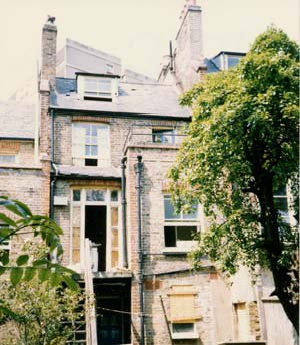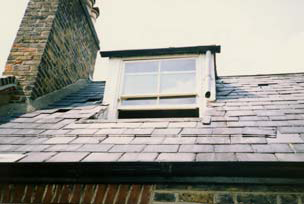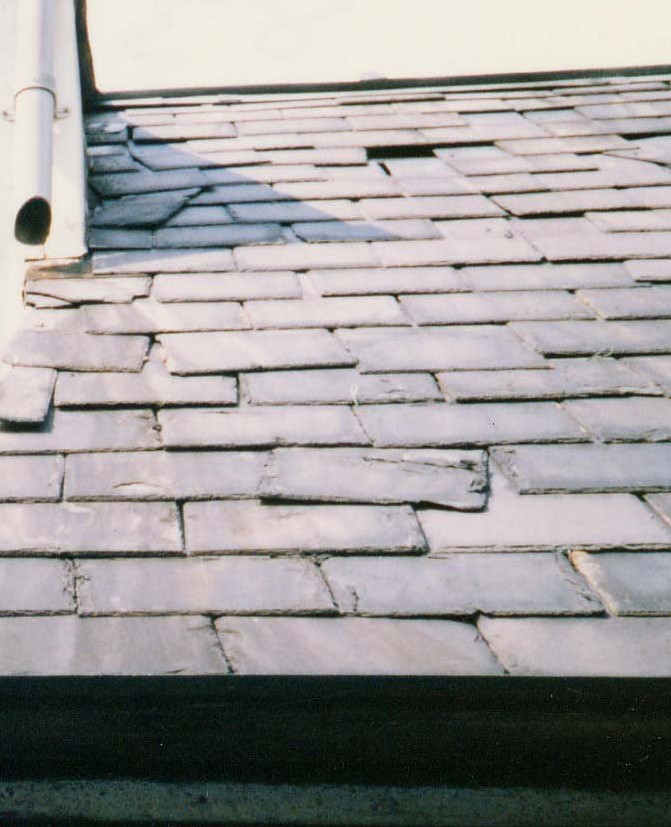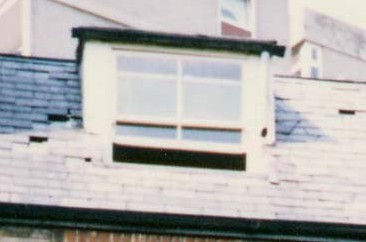



HHSRS VERSION 2
SEPTEMBER 2004
STRUCTURAL COLLAPSE
Vulnerable age
Related hazards
All ages
Damp and mould
HHSRS VERSION 2
Multiple locations
Yes
No
Secondary hazards
Yes
No
A) Slipped and missing slates on rear roof
DESCRIPTION OF HAZARD/S
B) Dormer to top floor rear room
Dwelling : Top dwellings in pre 1920 HMO
Background: The house comprises two floors plus a basement and attic and is generally in poor
repair. The rear roof, particularly, is affected by 'nail sickness' with many slipped and some missing
slates. The rear eavesgutter is loose. Chimney pots also appear unstable. Immediately below the
affected roof is a roof terrace for the top floor maisonette being assessed, and one floor below a wide
landing to common external stairs leading to the basement level garden. The hazard affects more
than one dwelling, but to different degrees.
LIST OF RELEVANT MATTERS
LIKELIHOOD
A
A
a
Structural movement
-
q
Defective floors
-
b
Structural cracks etc
-
r
Defective internal walls
-
c
Open joints - to brick etc
-
s
Insecure internal frames
-
d
Cladding defects
-
t
Loose fittings & fixtures
-
e
Loose coping(s)
-
f
Loose guarding
-
OUTCOMES
g
Structual damage
-
a
Height above ground
2
h
Disrepair to lintels/sills
-
b
Size/weight of element
3
i
Insecure frames or hinges
-
j
Roof movement
-
# Secondary hazards
k
Loose roof covering
3
None
-
l
Loose pots - to chimneys
3
m
Insecure rainwater goods
2
n
Staircase failure
-
o
Insecure guarding
-
Key
3
Seriously defective
1 Not satisfactory
p
Defective ceilings etc
-
2
Defective
- Satisfactory/NA
Likelihood to
1 in 5,600
Outcomes to
1.00 0.0 10.0 89.0 %
To reduce this hazard to average, the minimum works would include stripping, felting and
re-slating the whole of roof; renewing the rainwater goods; and replacing or removing the
chimney pots. However, other works are clearly required to the house as a whole. For
the top floor flat, the damp and mould growth - also resulting from the disrepair of this
roof - represents the most serious hazard, as shown by the previous worked example
(WE 01.2 V2).
Improved
IMPROVE
Justification
NEW RATING
Av: Nos
A B C D E F G H
I
J
Average likelihood, outcomes and HHSRS score for hazards from structural failure for all
persons in pre 1920 flats, 1997-99
Score
2
HHSRS VERSION 2
SEPTEMBER 2004
HEALTH AND SAFETY RATING SYSTEM SCORES
Pre 1920 Non s/c Flat
1 in
56
LIKELIHOOD
Low
High
Average: 24,098
Example
56
< 4200 2400 1300 750 420 240 130
75
42
24
13
7.5
4
2.5
1.5 >
Justification
OUTCOMES
Class I
Class II
Class III
Class IV
Justification
RATING
The likelihood of a person being struck by a falling element is significantly higher than
average. This is due to the location of the roof terrace above the back addition, this being
the only outdoor space available to the top floor maisonette, and the presence of the
common outdoor landing and stairs providing the main access to the basement level
garden. The fear of being struck, limiting the enjoyment of these outdoor spaces, is also
a factor increasing the likelihood of health outcomes such as stress as well as of physical
injury.
%
Average: 0.7
1.0
< 0.05 0.15 0.3
0.7
1.5
3
7
15
26
38 >
Av: 0.0
0.0
< 0.05 0.15 0.3
0.7
1.5
3
7
15
26
38 >
Av: 8.6
10.0
< 0.05 0.15 0.3
0.7
1.5
3
7
15
26
38 >
Av: 90.7
89.0
1.0
0.0
10.0
89.0
< 0.05 0.15 0.3
0.7
1.5
3
7
15
26
38 >
The health outcomes are judged to be no higher than average. However, with the high
likelihood of 1 in 56, this spread of outcomes gives a score of 248 and a band E rating.
Average: <1
I
J
Example
A B C D E F G H
248
Score
RATING SCORES AFTER IMPROVEMENT